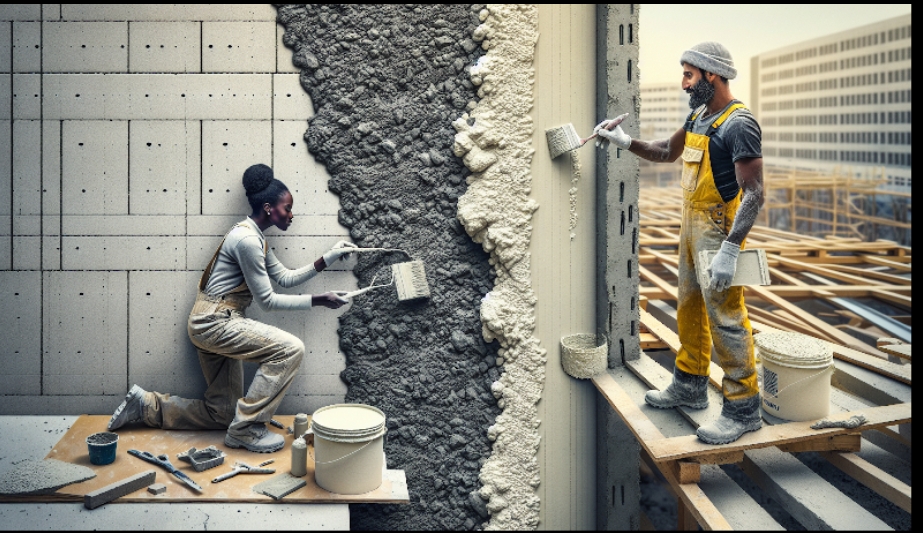Introduction to Home Insulation and Rendering
In recent years, the importance of home insulation has become increasingly apparent, as homeowners seek to reduce energy consumption, lower utility bills, and create a more comfortable living environment. Alongside traditional insulation methods, new advances in insulation render and concrete rendering have emerged, offering innovative solutions to enhance the thermal performance of buildings.
The Significance of Proper Insulation
Proper insulation is crucial for maintaining a comfortable and energy-efficient home. It helps to regulate indoor temperatures, prevent heat loss during winter, and reduce heat gain during summer. By minimising the transfer of heat through walls, roofs, and floors, insulation can significantly reduce the workload on heating and cooling systems, leading to lower energy consumption and utility bills.
Benefits of Effective Home Insulation
- Increased comfort: Insulation helps to maintain a consistent indoor temperature, eliminating drafts and cold spots.
- Energy savings: By reducing heat loss and gain, insulation minimizes the energy required for heating and cooling.
- Reduced environmental impact: Lower energy consumption translates to a smaller carbon footprint.
- Improved soundproofing: Insulation materials can also absorb noise, creating a quieter living space.
Traditional Insulation Methods
Before delving into the latest advances in insulation render and concrete rendering, let’s briefly explore some traditional insulation methods.
Fibreglass Insulation
Fibreglass insulation is one of the most common types of insulation used in homes. It consists of fine glass fibres that are spun into batts or rolls. Fibreglass insulation is relatively inexpensive and easy to install, making it a popular choice for many homeowners.
Cellulose Insulation
Cellulose insulation is made from recycled paper products, such as newspapers and cardboard. The paper is treated with fire retardants and insecticides before being shredded into small pieces. Cellulose insulation is often blown into wall cavities or attic spaces, providing excellent thermal performance.
Spray Foam Insulation
Spray foam insulation is a polyurethane-based material that is sprayed onto surfaces as a liquid and expands to fill gaps and crevices. It offers superior insulation properties and can also act as an air and moisture barrier. However, spray foam insulation is more expensive than other options and requires professional installation.
The Emergence of Insulation Render
Insulation render, also known as thermal render or external wall insulation (EWI), is a revolutionary approach to improving the thermal performance of buildings. It involves applying a layer of insulating material, typically expanded polystyrene (EPS) or mineral wool, to the exterior walls of a building, followed by a protective render coating.
How Insulation Render Works
Insulation render systems work by creating a continuous layer of insulation around the building envelope. The insulating material is fixed to the exterior walls using adhesives or mechanical fasteners, and then covered with a reinforcing mesh and a render coating. This process effectively wraps the building in a thermal blanket, reducing heat loss and improving energy efficiency.
Advantages of Insulation Render
- Improved thermal performance: Insulation render can significantly reduce heat loss through walls, leading to better energy efficiency and lower utility bills.
- Enhanced durability: The render coating protects the insulation material from weathering and damage, extending the lifespan of the system.
- Versatile application: Insulation render can be applied to both new construction and existing buildings, making it a suitable option for retrofitting.
- Aesthetic appeal: The render coating can be customised in various colours and textures, allowing for a wide range of design possibilities.
Concrete Rendering: A Complementary Solution
Concrete rendering is a technique that involves applying a mixture of cement, sand, and water to the exterior or interior walls of a building. While not primarily used for insulation purposes, concrete rendering can complement insulation render systems to enhance the overall performance and aesthetics of a building.
Benefits of Concrete Rendering
- Durability: Concrete render provides a strong and long-lasting protective layer for walls, resistant to weathering, impacts, and cracks.
- Fire resistance: Concrete is naturally fire-resistant, adding an extra layer of protection to the building.
- Moisture resistance: Properly applied concrete render can help prevent moisture penetration, reducing the risk of damp and mould growth.
- Aesthetic versatility: Concrete render can be finished in various textures and colours, allowing for creative design options.
Combining Insulation Render and Concrete Rendering
Insulation render and concrete rendering can be used together to create a high-performance building envelope. The insulation render system provides excellent thermal insulation, while the concrete render adds durability, fire resistance, and aesthetic appeal. This combination ensures that the building is well-protected against the elements and maintains its energy efficiency over time.
Advancements in Insulation Render Technology
As the demand for energy-efficient buildings grows, manufacturers and researchers are continually developing new and improved insulation render systems. Some of the latest advancements in this field include:
Nanotechnology-Enhanced Insulation Materials
Nanotechnology has the potential to revolutionise insulation materials by incorporating nanoscale particles that can enhance thermal performance, strength, and durability. For example, adding silica aerogel nanoparticles to insulation render can significantly reduce thermal conductivity, resulting in even better insulation properties.
Phase Change Materials (PCMs)
Phase change materials are substances that can absorb, store, and release heat energy during their phase transition (e.g., from solid to liquid). By incorporating PCMs into insulation render systems, it is possible to regulate indoor temperatures more effectively, reducing the need for active heating and cooling.
Biobased and Sustainable Insulation Materials
As sustainability becomes an increasing concern, researchers are exploring the use of biobased and recycled materials in insulation render systems. Examples include insulation materials made from plant fibres, such as hemp or straw, and recycled materials like rubber or plastic. These eco-friendly options can help reduce the environmental impact of building insulation.
Installation and Maintenance of Insulation Render Systems
Proper installation and maintenance are crucial for ensuring the long-term performance and durability of insulation render systems.
Professional Installation
Insulation render systems should be installed by trained and certified professionals to guarantee optimal results. The installation process typically involves the following steps:
- Substrate preparation: The wall surface is cleaned, repaired, and levelled as needed.
- Insulation board installation: The insulation boards are fixed to the wall using adhesives or mechanical fasteners.
- Reinforcement mesh application: A reinforcing mesh is embedded into a base coat of render to provide additional strength and crack resistance.
- Render coating application: The final render coating is applied, which can be textured or smooth, depending on the desired aesthetic.
Regular Maintenance and Inspection
To maintain the performance and appearance of insulation render systems, regular maintenance and inspection are necessary. This includes:
- Cleaning: The render surface should be cleaned periodically to remove dirt, dust, and organic growth.
- Crack repair: Any cracks or damage to the render should be promptly repaired to prevent water infiltration and further deterioration.
- Repainting: Depending on the type of render and exposure conditions, the surface may need to be repainted every 5-10 years to maintain its protective properties and appearance.
Case Studies and Real-World Applications
To illustrate the effectiveness of insulation render and concrete rendering in practice, let’s look at some case studies and real-world applications.
Residential Retrofit in the UK
A 1930s semi-detached house in the UK underwent a retrofit using an insulation render system. The homeowners reported a significant reduction in energy bills and improved indoor comfort after the installation. The project also demonstrated the potential for insulation render to enhance the aesthetic appeal of older properties.
Commercial Building Renovation in Germany
A commercial office building in Germany was renovated using a combination of insulation render and concrete rendering. The project achieved a 50% reduction in energy consumption and significantly improved the building’s fire safety and acoustic performance. The updated facade also contributed to a more modern and attractive appearance.
New Construction in Australia
A new residential development in Australia incorporated insulation render systems from the ground up. The developers chose this approach to meet the country’s strict energy efficiency regulations and to provide homeowners with long-term energy savings. The project showcased the seamless integration of insulation render in new construction.
Future Trends and Innovations
As the construction industry continues to prioritise energy efficiency and sustainability, insulation render and concrete rendering are poised for further innovation and growth.
Integration with Renewable Energy Systems
In the future, insulation render systems may be designed to integrate seamlessly with renewable energy technologies, such as solar panels or heat pumps. This integration could optimise the overall energy performance of buildings and contribute to the transition towards net-zero energy structures.
Smart Insulation Materials
The development of smart insulation materials that can adapt to varying environmental conditions is an emerging trend. These materials may incorporate sensors and adaptive technologies that adjust their thermal performance based on real-time data, enhancing energy efficiency and comfort. For example, smart insulation materials could react to changes in temperature, humidity, or occupancy levels to provide optimal thermal regulation.
Advances in Eco-Friendly Render Solutions
The focus on sustainability is likely to drive further innovation in eco-friendly render solutions. Expect to see more developments in bio-based and recycled materials that offer improved performance while reducing environmental impact. Additionally, manufacturers may explore low-carbon and low-impact production methods to align with global sustainability goals.
Improved Durability and Longevity
Future advancements in insulation render and concrete rendering will likely focus on increasing the durability and lifespan of these systems. Innovations in materials and application techniques could lead to render systems that are more resistant to environmental factors, such as UV radiation, extreme temperatures, and chemical exposure. Enhanced durability will contribute to lower maintenance costs and longer-term performance.
Conclusion
The revolution in home insulation and rendering technologies is paving the way for more energy-efficient, comfortable, and aesthetically pleasing buildings. Advances in insulation render and concrete rendering offer innovative solutions that enhance thermal performance, durability, and sustainability. As technology continues to evolve, these solutions will play a crucial role in addressing the challenges of energy efficiency and environmental impact.
By staying informed about the latest advancements and working with experienced professionals, homeowners and builders can leverage these innovations to create high-performing, sustainable buildings that meet modern demands. Whether through insulation render, concrete rendering, or a combination of both, the future of home insulation is bright with possibilities for improved comfort, efficiency, and environmental stewardship.
Call to Action
As you consider upgrading your home’s insulation or exploring rendering options, consult with experts who can provide insights into the latest technologies and best practices. Whether you’re undertaking a renovation or new construction project, investing in advanced insulation and rendering solutions will not only enhance your home’s performance but also contribute to a more sustainable future. Contact a professional today to discuss how you can benefit from these cutting-edge advancements in home insulation and rendering.




